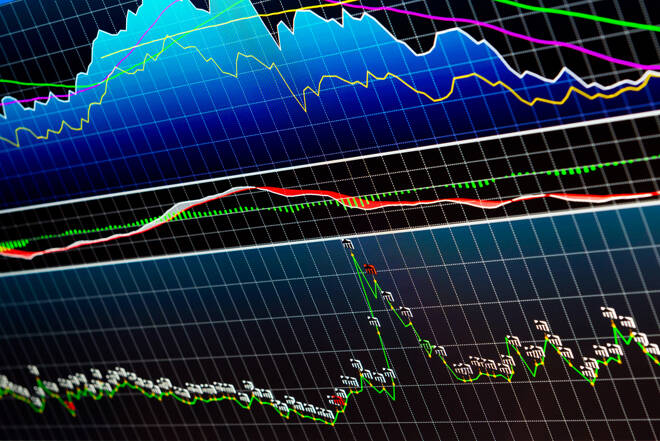Advertisement
Advertisement
What is a Moving Average
By:
Intro
Moving Average is one of the basic technical indicators that every chartist comes across. It is a smooth line indicating the average of closing prices for a specified period.
It defines the prevailing direction of the movement but doesn’t predict future movements. That makes it a ‘lagging indicator’. Despite the lag, moving averages eliminate the day-to-day price fluctuations that are inherent in all financial markets and help to smoothen price action. It also helps to identify the support and resistance levels signaling trend reversals.
There are various types of moving averages but the two most popular are: the Simple Moving Average (SMA) and the Exponential Moving Average (EMA). The following article provides a brief overview of moving averages and describes theirbenefits and limitations.
Types of Moving averages
The most popular types of moving averages are Simple, Exponential, Smoothed and Weighted Moving Averages. The simple moving average is the most basic and the most famous one as it’s easy to plot,while the weighted moving average is less famous as it’s difficult to understand and plot.
Simple Moving Average (SMA)
TheSimple Moving Average (SMA) is the average or the mean price over a certain period of time and is calculated by taking the arithmetic mean of a given set of values and hence equal weightage is given to each price. It is the easiest to plot, but also the most prone to distortion.
Exponential Moving Average (EMA)
The usefulness of the SMA is limited because each point in the data series is weighted the same, regardless of where it occurs in the sequence. The most recent data is more significant than the older data and should have a greater influence on the final result. To overcome this difficulty, the usage of EMA that gives more importance to the recent prices in an attempt to make it more responsive to new information, started gaining pace.
Smoothed Moving Average (SMMA)
Even giving more importance to the recent times, EMA creates more noise which makes it less suitablefor longer term analysis. Smoothed Moving Average, is a blend ofa Simple Moving Average and an Exponential Moving Average. It is calculated according to the following formula:
SMMA = (SUM1 – SMMA1+CLOSE)/ N
SUM1 – The total sum of closing prices for N periods;
SMMA1 – The smoothed moving average of the first bar;
SMMA – The smoothed moving average of the current bar (except the first one);
CLOSE – The current closing price;
N – The smoothing period.
Hence, the smoothed moving average is derived by using features of simple and exponential moving averages, which makes it more usefulforconducting technical analysis. Though, the difficulty in plotting as well as the higher lagging value makes it less suitable for short term analysis, which interests the majority of traders.
Weighted Moving Average (WMA)
Even though the SMMA gives precise values compared to SMA and EMA, the lagging value makes it less suitablefor technical analysis. Weighted Moving Average gives more importance to the recent price moves than the older ones and excludes the lagging factor. Herein, the factor is assigned to each value based on the total period understudy (not like the exponential weight given to the each value under Exponential Moving Average).
The difference between EMA and WMA is that all the weights in WMA carry the uniform impression as all of them are strictly based on the mentioned time period, while weight in EMA carries the exponential values as it depends on the period outside of the mentioned time frame. Though, WMAsare difficult to plot, they are more reliable for conducting technical analysis.
Important Functions of a Moving Average
Moving Averages performa lot ofother functions in addition to signifying the trend. It helps to identify the trend reversal based on the cross over and cross under of the price to the moving average/moving averages. It also signals the strength of momentum during the mentioned timeframe, which makes it useful to determine price trends during different time periods. Furthermore, it helps to identify the support and resistance levels, which is the most basic and famous function of moving average. Hence, Moving Averages don’t only signal the average trading price during a specified period, theyalso perform various other functions helpful for technical analysis.
Crossovers
Сrossoversare sone of the most important aspectsthat every trader considerswhen using moving averages. It is the behavior of the price to surpass moving average. Price crossovers are used to identify shifts in momentum and can be used as a basic entry or exit strategy.
The most basic type of a crossover is when the price moves from one side of a moving average and closes on the other. A cross below the moving average suggests that the market price is losing momentum and can signal the beginning of a downtrend. Conversely, when the price moves above a moving average from below would suggest that the price is trending upwards.
Another type of crossover takes place between multiple moving averages. Herein, if the shorter term moving average cuts down the longer term moving average, it signals the downtrend, conversely, if the longer term moving average plunges below the short term moving average, it signals the uptrend.
Conclusion
Moving averages are an easy technical tool which is useful for making technical analysis. Besides being a lagging indicator, they are the base forvarious complex technical tools. Remember, using solely themoving average for confirmation is not enough for making a wise trading decision.It should also be backed by various other technical indicators like: CCI, RSI, MACD, etc.
About the Author
Haresh Menghaniauthor
Advertisement
Table of Contents
Advertisement
Advertisement
Advertisement
Advertisement
